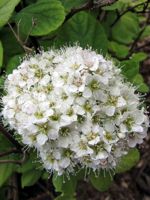Mon-Fri 9am - 5pm Mountain time
Western Snowberry vs Birch Leaf Spirea
Spiraea betulifolia
Symphoricarpos occidentalis
NOT AVAILABLE THIS SEASON - MIGHT RETURN
NOT AVAILABLE THIS SEASON - MIGHT RETURN
Birch Leaf Meadowsweet is a small, rounded shrub, reaching 3 to 4 feet high.
In the early summer, white flowers emerge with dark green foliage. Come fall, birch-like leaves turn a kaleidoscope of red, orange, and purple adding seasonal interest.
Native to Japan and Eastern Asia, this dwarf shrub attracts butterflies and is an excellent option for the front row of a shrub border.
Like the Common Snowberry, the Western Snowberry is a small shrub with pink flowers useful for feeding livestock and preventing erosion. Unlike the common species, however, the Western Snowberry is much more suited to wet conditions, capable of persevering through poor soil drainage and occasional flooding.
After the Snowberry's flowers have bloomed, it produces berries which often last on the plant through winter. These berries are toxic to humans, but livestock and local wildlife love them! Those hoping to attract wildlife to their property can plant Snowberry and expect to see animals foraging on it much later in the year than other plants.
Birch Leaf Spirea Quick Facts
Western Snowberry Quick Facts
Toxicity: berries are toxic to humans

